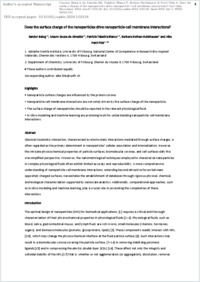Does the surface charge of the nanoparticles drive nanoparticle–cell membrane interactions?
DOKPE
- Balog, Sandor ORCID Adolphe Merkle Institute, University of Fribourg
- de Almeida, Mauro Sousa Adolphe Merkle Institute, University of Fribourg
- Taladriz-Blanco, Patricia Adolphe Merkle Institute, University of Fribourg
- Rothen-Rutishauser, Barbara Adolphe Merkle Institute, University of Fribourg
- Petri-Fink, Alke Adolphe Merkle Institute, University of Fribourg
- 2024
Published in:
- Current Opinion in Biotechnology. - Elsevier BV. - 2024, vol. 87, p. 103128
English
Classical Coulombic interaction, characterized by electrostatic interactions mediated through surface charges, is often regarded as the primary determinant in nanoparticles' cellular association and internalization. However, the intricate physicochemical properties of particle surfaces, biomolecular coronas, and cell surfaces defy this oversimplified perspective. Moreover, the nanometrological techniques employed to characterize nanoparticles in complex physiological fluids often exhibit limited accuracy and reproducibility. A more comprehensive understanding of nanoparticle-cell membrane interactions, extending beyond attractive forces between oppositely charged surfaces, necessitates the establishment of databases through rigorous physical, chemical,
and biological characterization supported by nanoscale analytics. Additionally, computational approaches, such as in silico modeling and machine learning, play a crucial role in unraveling the complexities of these interactions.
and biological characterization supported by nanoscale analytics. Additionally, computational approaches, such as in silico modeling and machine learning, play a crucial role in unraveling the complexities of these interactions.
- Faculty
- Faculté des sciences et de médecine
- Department
- Adolphe Merkle Institute
- Language
-
- English
- Classification
- Engineering materials
- License
- Open access status
- green
- Identifiers
-
- DOI 10.1016/j.copbio.2024.103128
- ISSN 0958-1669
- Persistent URL
- https://folia.unifr.ch/unifr/documents/332921
Statistics
Document views: 101
File downloads:
- balogetal.currentopinioninbiotechnology2024-aam: 51
